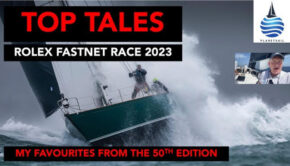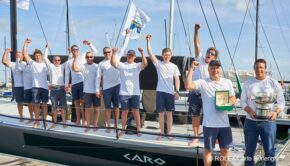Fastnet Race: Find the wind, Follow the wind
Published on August 17th, 2015
(August 17, 2015; Day 2) – Different options around the Scilly Isles have been put to effect today at the front of the Royal Ocean Racing Club’s Rolex Fastnet Race with the leaders taking three significantly different routes, hoping to make the best of the complex Celtic Sea weather on the 150 mile leg northwest to the Fastnet Rock off southwestern Ireland.
This morning the multihull frontrunners took the most circuitous route. Rather than heading northwest at Land’s End, instead they left the Scilly Isles to starboard, continuing due west into the strongest breeze before gybing north this afternoon with the wind building. Here, in stark contrast to the rest of the race course, the wind was blowing 15-20 knots. At 1500 UTC Dona Bertarelli and Yann Guichard’s 40m trimaran Spindrift 2, was eating up the miles, making 28 knots with some 37 miles to go to the Fastnet Rock. Behind her, the trio of MOD70s and the Multi 80 Prince de Bretagne were only a knot or two slower.
Among the biggest monohulls, George David’s Rambler 88 and Mike Slade’s Farr 100 Leopard, followed the same course as the multihulls while Jim Clark and Kristy Hinze Clark’s 100ft Comanche and Dieter Schon’s Maxi 72 Momo, chose a more ‘conventional’ route between the Scilly Isles and the Land’s End Traffic Separation Scheme (TSS). This move benefitted Rambler 88 allowing her to close from seven miles behind this morning, to one mile behind as the two boats converged mid-afternoon.
At lunchtime, while south of the TSS, skipper Chris Sherlock reported that on Leopard they had eight knots: “the most we’ve had for some time.” Since the start Leopard had done an admirable job keeping up with the brand new Rambler 88, however owner Mike Slade reported: “From the Lizard onwards we fell into a bit of a hole and it was not at the right angle for us and they pulled out on us. But we are going south of the TSS which we hope will help get us back. There is a lot to play for and it is nice to get a bit of breeze because it was very, very soft all through the night.”
The multihulls have broken away from the top four monohulls, but the latter in turn have broken away from the boats behind them and at a stroke may have turned the 90th anniversary Rolex Fastnet Race away from being a ‘small boat race’ into a ‘large boat’ one.
All but becalmed this morning between the Lizard and Land’s End, the IMOCA 60s have chosen a third option across the Celtic , gybing north up the narrow channel between the Land’s End and the TSS. The Seven Stones light vessel here was recording a 3-4 knot SSE-SSW wind this afternoon.
Among the IMOCA 60s, Quéguiner – Leucémie Espoir was technically leading this afternoon, but the top four 60s were neck and neck alongside the VO65 Team SCA and the VO70 Camper. A second wave of IMOCA 60s was following on the same route, impressively with Peter Harrison’s TP52 Sorcha up among them, punching well above her weight.
Campbell Field, navigator on Sorcha, explained why they are heading north: “A lot of current and some current-generated breeze up the coast. The ridge [to their northwest] is not going anywhere and we know that we are going to have to transit across it at some stage, but this is how the cards are dealt and to sail in the best breeze this is where we’ve ended up going. Once we get up towards the northeast corner of the TSS then we are going to start meeting the zone of death of no wind and we’ll have to do the best we can to get across it into the southerlies on the other side.”
Behind, the bulk of the fleet has been divided into distinct groups thanks to the tide changes. Just past the Lizard but inshore, Tony Lawson’s Concise 8 leads the Class40s, just ahead of Richard Dobbs’ Swan 68 Titania and Stuart Whitehead’s new Carkeek 40 Mk2 Rebellion.
A more offshore group to their south, was being led by the French Class 40 Cabinet Z with Irishman Anthony O’Leary’s turbocharged Ker 40 Antix and the powerful French A-13 Teasing Machine astern of her.
Behind, the bulk of the fleet after rounding Start Point had gybed and was heading inshore towards the Cornish coast, in order to find adequately shallow water ready to kedge later this afternoon.
Admiral of the RORC, Andrew McIrvine sailing the First 40 La Réponse already had some anchor practice last night when the wind dropped off 12 miles south of Portland. They anchored in 57m of water. “It helped us a bit – I don’t think anyone else was daft enough to try that! We put out about a million miles [of anchor line] and then we pulled it back in when the wind filled in.”
McIrvine said that he didn’t see anyone else anchor as it was so deep. Instead the other boats nearby got swept south towards the Casquets TSS in the middle of the English Channel.
This afternoon La Réponse was 10 miles due south of Plymouth in 2.7 knots of wind from the south-southwest with the 2013 Rolex Fastnet Race winner, the JPK 10.10 Night And Day just astern of her. “The only reason we are moving is that we have 1.5-2 knots of tide under us,” McIrvine continued. “Once that goes we’ll be kedging again. I am heading in towards the inside of the Lizard, then we’ll have to sit it out for six hours to get around the Lizard on the next tide.”
Despite the gloomy forecast, McIrvine with pleased and slightly surprised by the progress they had made so far including a relatively fast crossing of Lyme Bay.
On the Elan 40 Flair IV, Pip Hare, racing two handed with Ashley Harris, was also having an afternoon better for sunbathing than racing. “At the moment we have got one knot. Sometimes we even get boat speed, which is really quite exciting.” Early afternoon they had their Code 0 up but it was hanging limply and Hare was optimistically hoping, perhaps praying, for some sea breeze to fill in. “We are trying hard not to eat our entire supplies of food through boredom.”
Unlike La Réponse, Flair IV was one of the boats that got sucked south towards the Casquets TSS, which Hare said they were in danger of encroaching into (forbidden under race rules). “We had to spend the best of two hours sailing backwards so that we didn’t clip the corner, which was just death for us. We were expecting to get a lift, but it was too little too late. That definitely wasn’t in the game plan, but it was the same for quite a few people.”
UPDATE: Spindrift 2 rounded the Fastnet Rock at 16:49:51 BST (17 August). Also, this afternoon a crewman on Southern Child suffered a severe scalding and the First 40 suspended racing at 1410 BST to disembark the injured person onto the Plymouth lifeboat. Albeit in a stable condition, from there they were taken to hospital for treatment.
Event details – Entry list – Tracker
Report by James Boyd.
Background: The 603nm Rolex Fastnet Race is organised by the Royal Ocean Racing Club (RORC), with the 46th edition of the biennial race to start off the Royal Yacht Squadron line, Cowes, Isle of Wight on Sunday 16th August 2015. It is the largest offshore race in the world and attracts the most diverse fleet of yachts.











 We’ll keep your information safe.
We’ll keep your information safe.